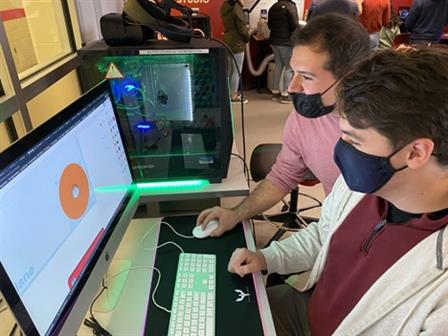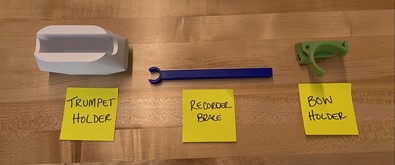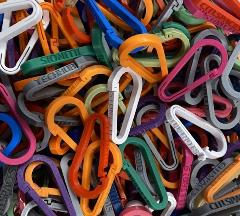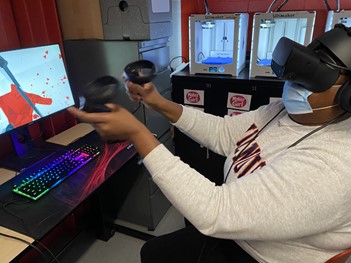
University of Illinois music education majors James Karavites, at right, and Tyler Munguia use Tinkercad software to create a 3D design of a vinyl record at the Center for Innovation in Teaching & Learning’s Innovation Studio. Recently, Karavites, Munguia, and other students in Assistant Professor Donna Gallo’s MUS 439: Differentiating Music Instruction course visited the Innovation Studio to learn about 3D printing and other emerging technologies and how they can apply them to their field.‘The possibilities are endless’
Music ed students’ visit to CITL’s Innovation Studio exposes them to emerging technologies, applications in their field
Music education majors must know music theory and musicianship, composition and conducting, and piano and usually another instrument to be able to teach K-12 students.
But Donna Gallo, an assistant professor of music education at the University of Illinois Urbana-Champaign, also wants them to have some knowledge of 3D printing, virtual reality, and other emerging technologies.
“I think being in the School of Music, we don’t use these resources enough,” said Gallo, who earlier this month, brought students in her MUS 439: Differentiating Music Instruction course to the Center for Innovation in Teaching & Learning’s Innovation Studio to learn about some of these high-tech tools and experience them firsthand.
“There are so many applications for music and teaching music,” Gallo continued. “The more exposure they have to these technologies and the possibilities they provide, the more opportunities they’ll be able to provide for their students.”
Located at 172 Armory Building, the Innovation Studio is a high-tech experiential learning classroom featuring 3D and laser printers, virtual reality headsets, powerful gaming computers, a six-screen multitouch video wall, a 55-inch interactive touch table, drones, and more. It’s open for tours, events, and visits by individuals, registered student organizations, and university courses from 10 AM to 4 PM CST on Tuesdays or by appointment.
This semester, students from a dozen or so courses visited the studio, said Jamie Nelson, CITL’s Associate Director of Emerging Educational Technologies. A number tried their hand at VR. For example, fashion design students used a program to design clothing, social work students used another to practice de-escalation techniques, and art students learned about visualization.
“We’ve also hosted industrial design, architecture, physics students,” Nelson said, adding the studio’s mission “is to empower people through the power of emerging technologies.
“We try to show them what’s available, and how they’re being used in their fields,” he continued. “That’s what’s so cool. These technologies have applications across the board, and the possibilities are endless.”
MUS 439 is a course that explores strategies for adapting and modifying music instruction for students with disabilities in general, choral, and instrumental music classes. Earlier in the semester, Gallo was excited to show her students the 3D print designs for adaptive pieces for musical instruments that she found on the website Thingiverse and then asked Nelson to print.

Jamie Nelson, CITL’s Associate Director of Emerging Educational Technologies, created these adaptive pieces for musical instruments on CITL’s 3D printer. Assistant Prof. Donna Gallo (Music Education) found the designs on the website Thingiverse, and asked Nelson to print them to help her students engage more deeply with the concepts they learned in class. She was even more excited when during their Nov. 12 course visit, Nelson showed them the printed items—a recorder brace, a bow holder, and a trumpet holder.
“That’s awesome!” she exclaimed, adding later, “I didn’t just have to show my students the draft of the devices online. It's really wonderful that we have maker spaces that will print things for us (within reason) that enable us to engage more deeply with concepts and possibilities.”
During the visit, CITL student employee Juliette Speck treated Gallo’s students to a lesson in 3D printing.
“I’ve taught 7-year-olds how to 3D print, so I’m confident you’re going to get it,” joked Speck, a senior computer science and chemistry major and who previously worked at MakerGirl, an organization that inspires girls to be active in STEM through 3D printing workshops.
While printers range from simple ones for beginners, costing roughly $200 to $300, to large industrial printers that cost $100,000 or more and can print different types of materials and in full color, Speck said the studio’s printer is basic, meaning “it’s fairly slow and can only print one color” at a time.
The process starts by creating a design using CAD (computer-aided design) software, Speck explained.

Colorful mini clips that Innovation Studio staff have printed on the 3D printer.
“We’re using Tinkercad,” she said, referring to an online 3D modeling program that’s free.
Next, the design is imported to a slicing software like Cura, which converts the information into a Gcode. Gcode is the language that tells the 3D printer how to print the object.
“Then, you print,” Speck said, explaining that a nozzle extrudes a plastic filament into the printer, and the machine prints the object layer by layer.
At that moment, the printer was creating a mini clip. Nelson held up a jar of the colorful clips with “Illinois,” “CITLSpaces,” and “TechHub” etched on them and invited students to take one.
On the video wall, Speck showed students real-world examples of 3D printing including building and housing prototypes, items used in STEM fields and for STEM education, and the soles of Nike shoes.
“It’s in almost every field now,” she said.
Nelson also showed students a homegrown example—an adaptive glove for wheelchair racing that was designed in the Illinois MakerLab, started in the Gies College of Business, and then further customized at Beckman Institute.
Nelson told students that he, too, goes to Thingiverse, to search for 3D printing designs. Thingiverse is a website that anyone can go to find designs for all types of things and download them for free. He demonstrated by searching for “ukulele” and brought up several colorful designs made of plastic and another made of wood.
“There’s all kinds of stuff that’s already available,” he said, adding the designs on the website can be modified.
 Music education student Ben Macke holds a medallion of a cat that he created using the 3D laser cutter in the Innovation Studio.
Music education student Ben Macke holds a medallion of a cat that he created using the 3D laser cutter in the Innovation Studio.
After the presentation, students were free to explore the classroom and all it had to offer.
Ben Macke sat down at a computer near the laser printer and found a design that was sure to please his mom.
“It only took two minutes” to print, he said, holding up a small wooden disc with an etching of a cat.
After watching the process, Elizabeth Meyer took a turn and etched her sorority letters on a disc.
“I think it’s so cool that there’s a resource here that students can use for free,” she said. “As this technology becomes more available, we’re going to need to know about it and how to use it. It just enables us to better help our students.”
Across the room, Tyler Munguia and James Karavites used Tinkercad software to create original designs.
Karavites designed a red rectangle-shaped block with “Music Ed Rox!” in blue letters.
Munguia designed a vinyl record. He planned to add a “Class of ’22” or “University of Illinois School of Music” logo.

Diamond Arrington plays a VR game during her course visit to the Innovation Studio.
Diamond Arrington got so caught up in a VR game she was playing that she didn’t realize that the visit was ending, and it was time to go. She hopes to continue exploring VR and other tools as a student and throughout her career as a music teacher.
“We do a lot of cross-cultural experiences to show our students where their music comes from,” Arrington said, referring to different countries and cultures. “I think learning about that (through VR) can give them a deeper experience. They’re not just seeing it on Google or hearing us talk about it. That’s going to give them a deeper interest and understanding.”
Gallo also wished she and her students could have stayed longer but hopes the students will return.
"I think they enjoy it and hope for more opportunities like this where they can connect their musicianship and pedagogy to emerging technologies,” she said.
Are you interested in hosting your course at CITL’s Innovation Studio? Email the staff at armoryinnovationspaces@email.com or use this form to schedule an appointment.